Non-carved superheroes. Who and how protects the construction site of Lakhta Center from fires?
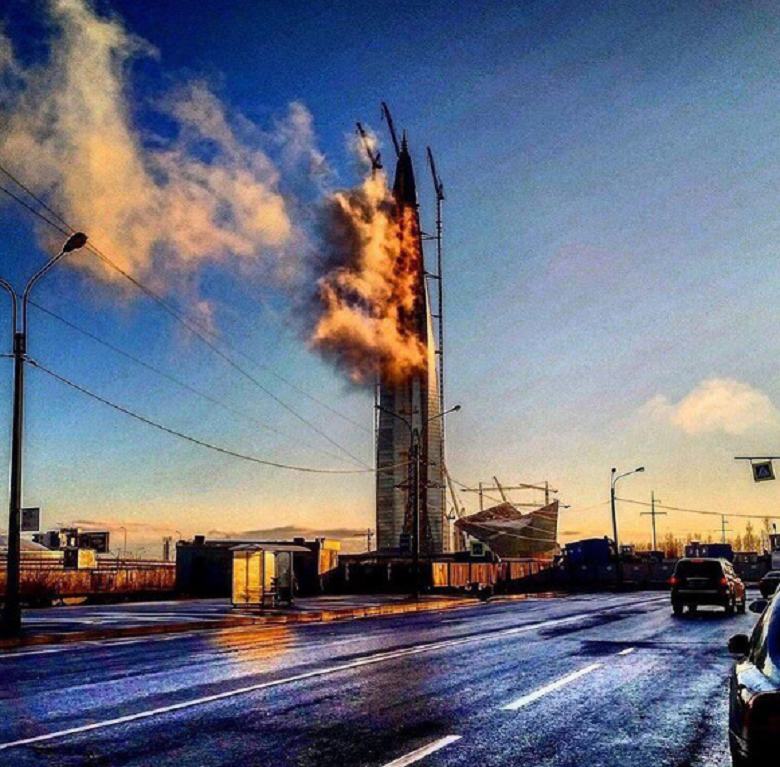
Do you think the photo is on fire or not? In this post we tell - did there ever have been a fire in Lakhta Center or not? And also - why is the danger of a fire at a construction site higher than in a finished building? How to deal with it? Finally, why did we deceive you when we were told that the core was gaining height in the Lakhta Center tower, and that it was actually built ahead of the skyscraper.
WHY FIRE DOESN'T LOVE BUILDINGS
Everyone knows that firefighters do not like skyscrapers. Firemen do not like more skyscrapers only their construction sites. The construction of a high-rise building is always a risk zone.
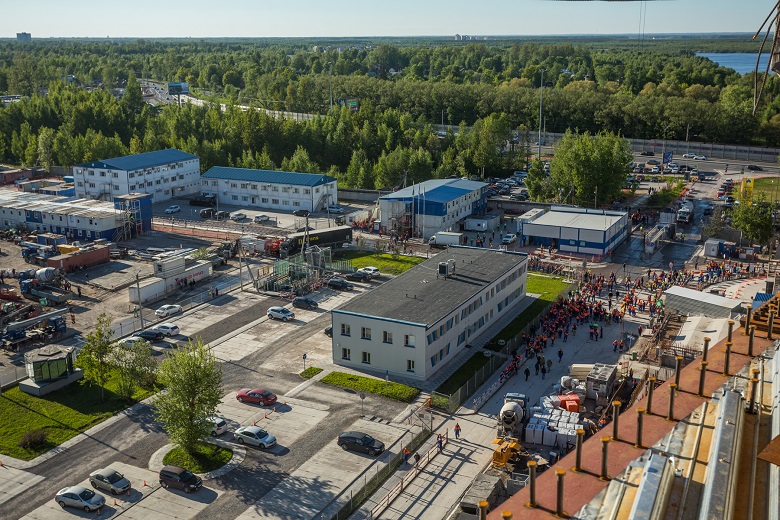
')
Thousands of people work here, hundreds of technological operations are being performed at the same time, including such “bad” things like welding or laying electrical networks, and non-standard heating and heating devices are also used. On sites closely - maneuvers complex equipment, materials are stored, temporary construction towns are built ...
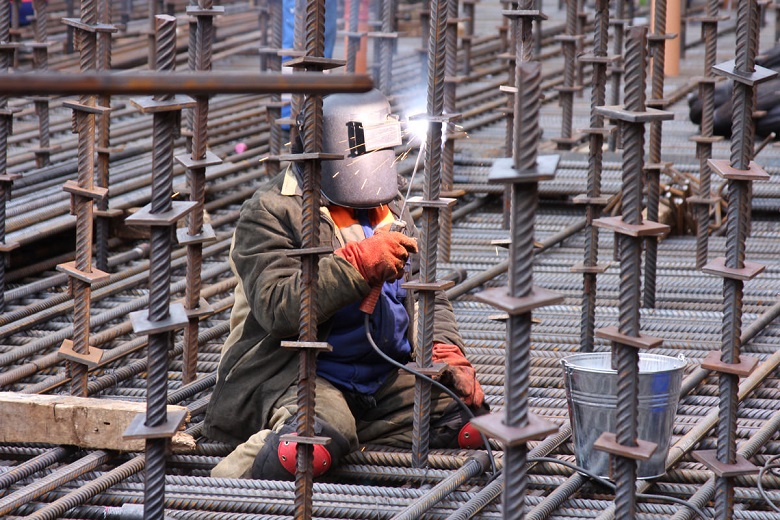
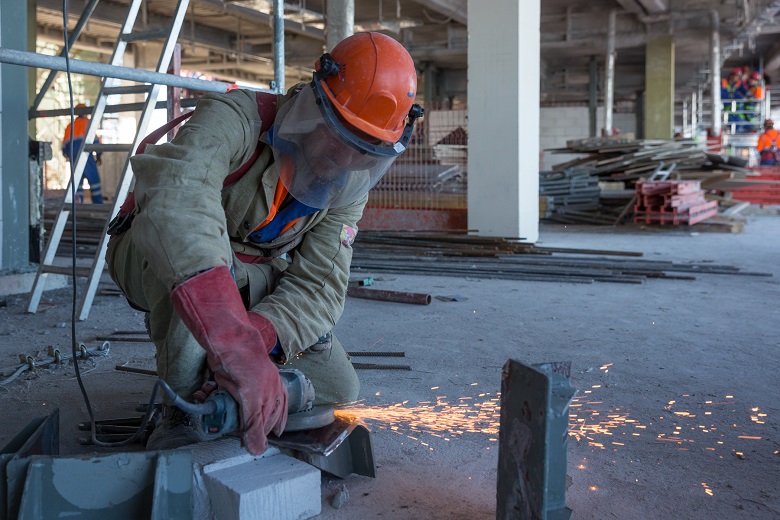
Firing and welding at the construction site of Lakhta Center, archive
Worst of all, the building landscape is constantly changing: the building is growing and there can be no unchanged plan of action - you need to constantly study the situation. And fire systems? After all, they are not at all the same as in the finished object. Feelings of the fire service are understandable.
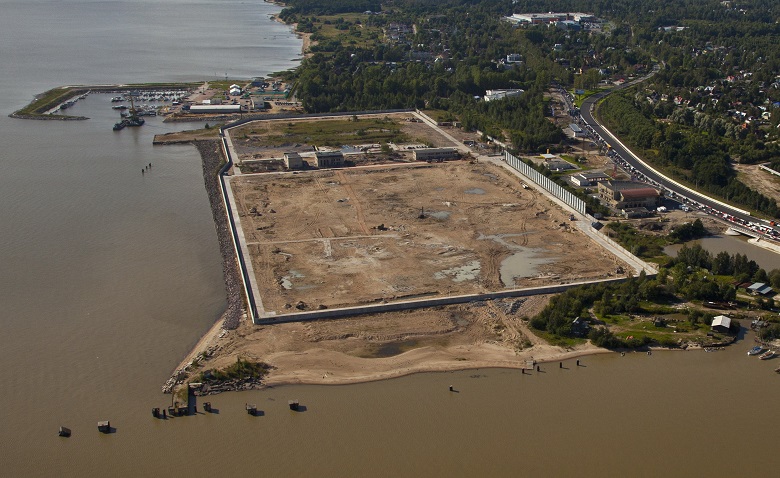
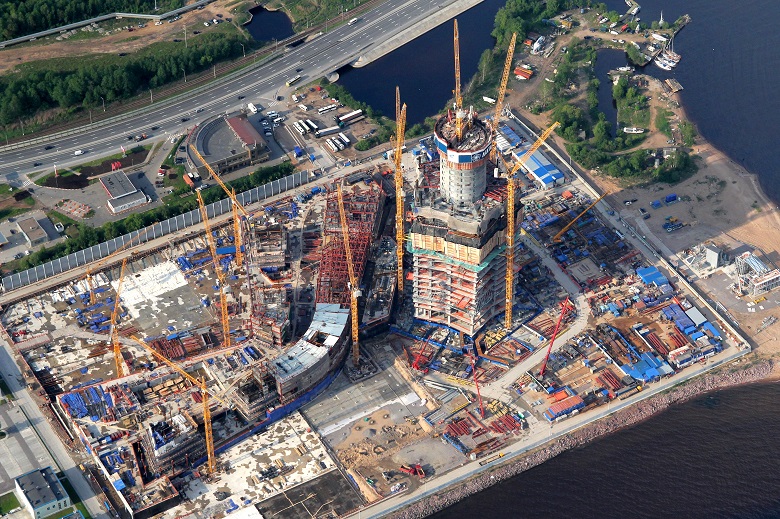
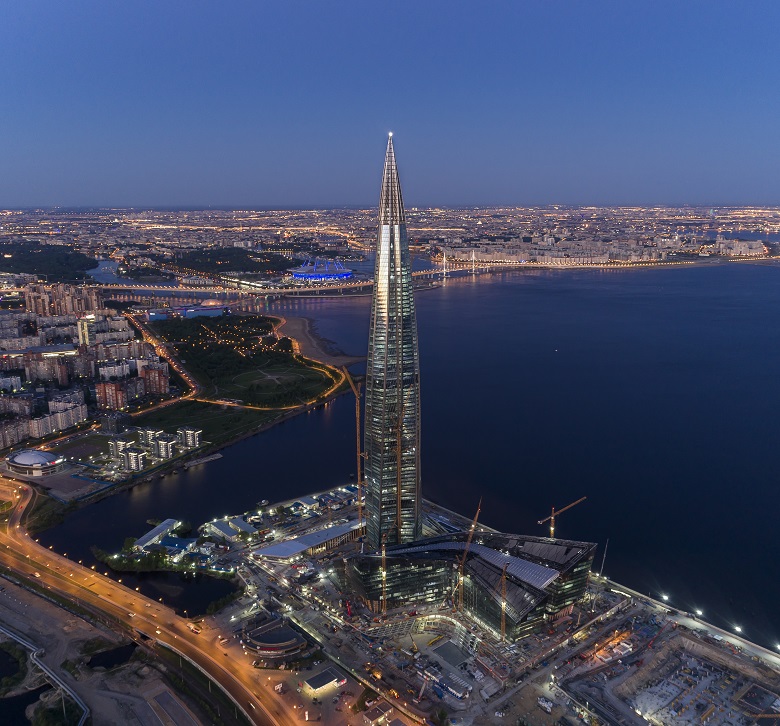
Changes in the construction landscape during the construction of the Lakhta Center complex, 2012-2018
Sometimes firemen - perhaps with the thought: “So we knew!”, Expressed a little less literary, go to the construction site. Fires in unfinished skyscrapers are not such an exceptional rarity. One of the closest examples to us is the state of emergency of 2012 in the Vostok tower under construction in the business complex Federation in Moscow City. Due to the contact with the hot surface of the spotlight, the material covering the formwork caught fire. The fire occurred on the 67th floor and spread over an area of 300 m2. Extinguished in a few hours. Could and faster, but, as it turned out, did not work building fire conduit. Thanks to firefighters, that there were no injuries and major damage to the building.
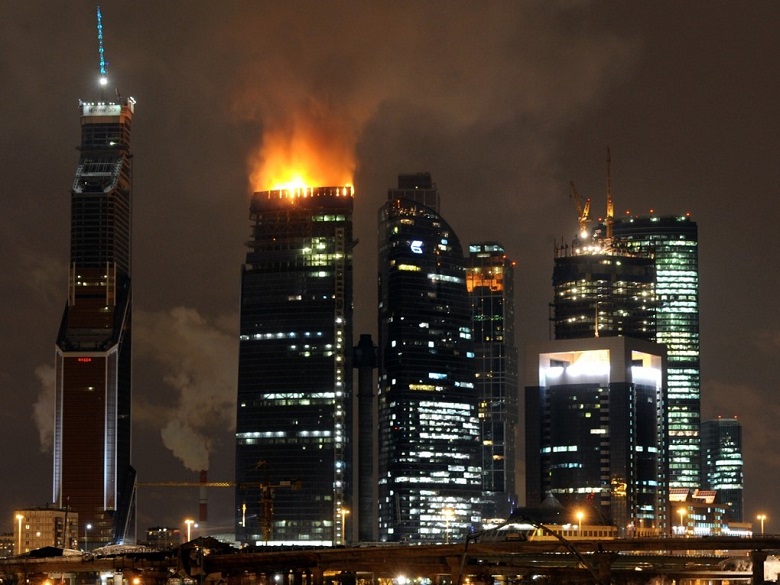
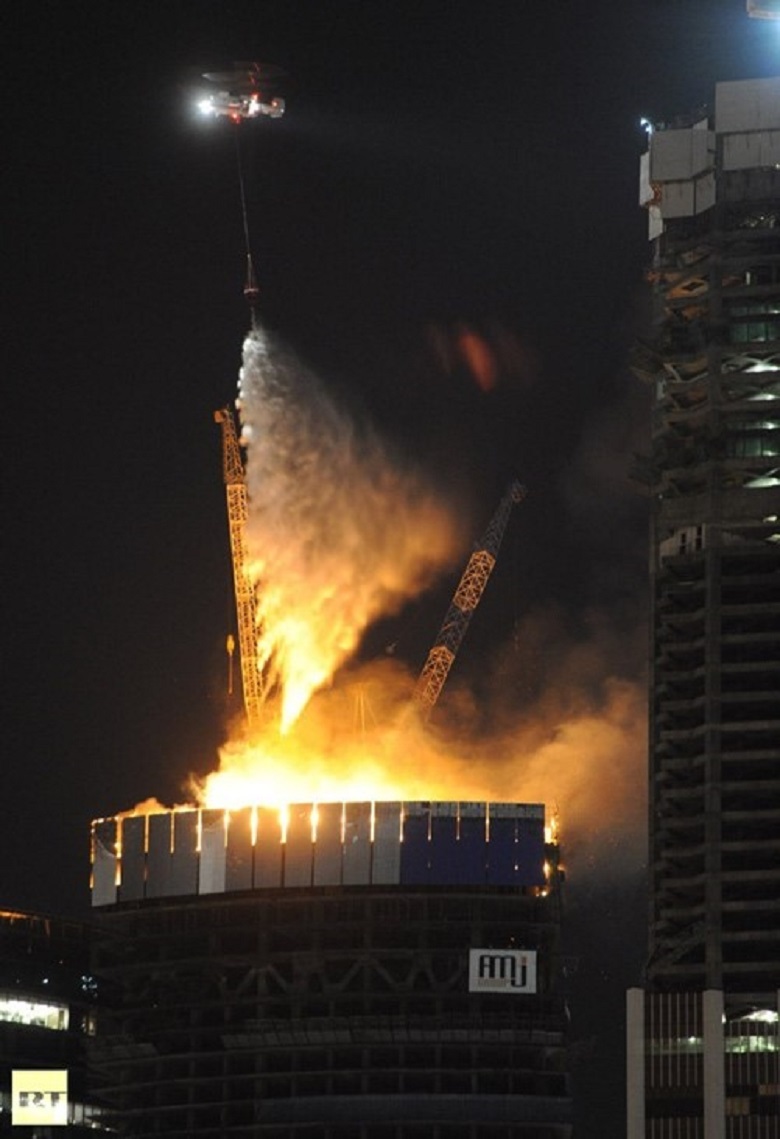
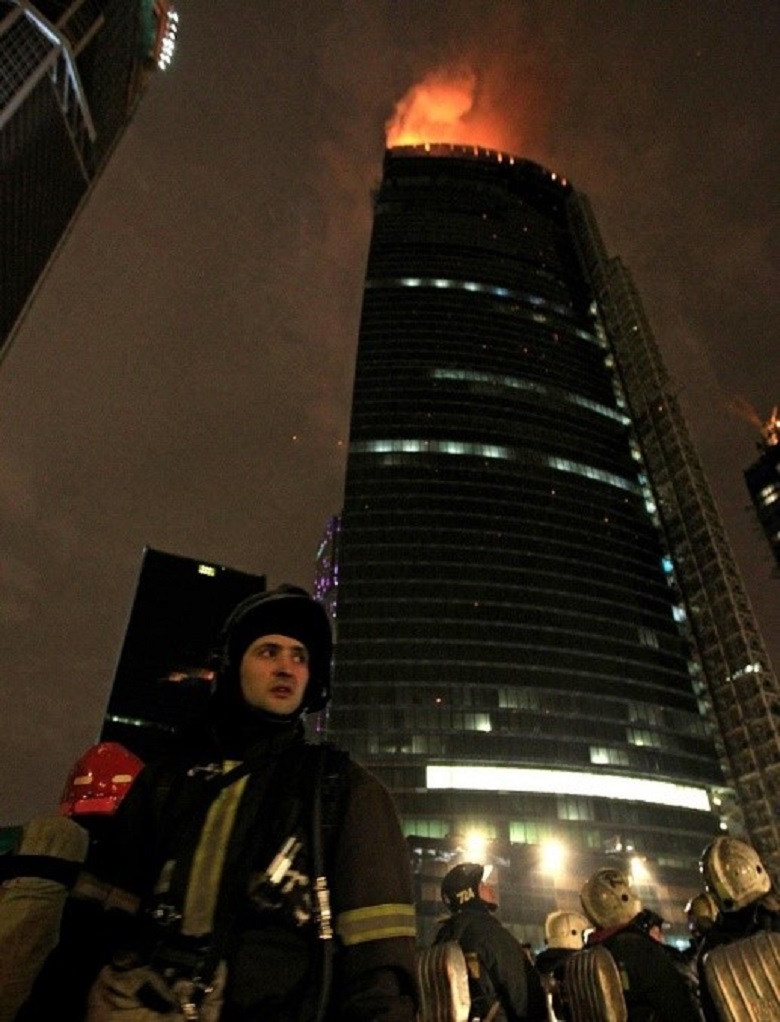
Much more serious is the 2013 event in the Olympus 145-meter tower of the Grozny-City complex. The installer used a gas torch for gluing the joints of a soft roof and accidentally set fire to the material. Strong wind - fire spread to the facade, covered with "plastic elements" and within half an hour, he embraced the building, as reported by eyewitnesses.
Grozny firefighters did not have equipment capable of reaching the required floor, there is no information about the water conduit. Aircraft of the Ministry of Emergency Situations entered the fight only the next morning - the wind, darkness and dense building prevented aviation from flying to help immediately. There were no casualties. Firefighters completely evacuated not only Olimp, but also neighboring buildings.
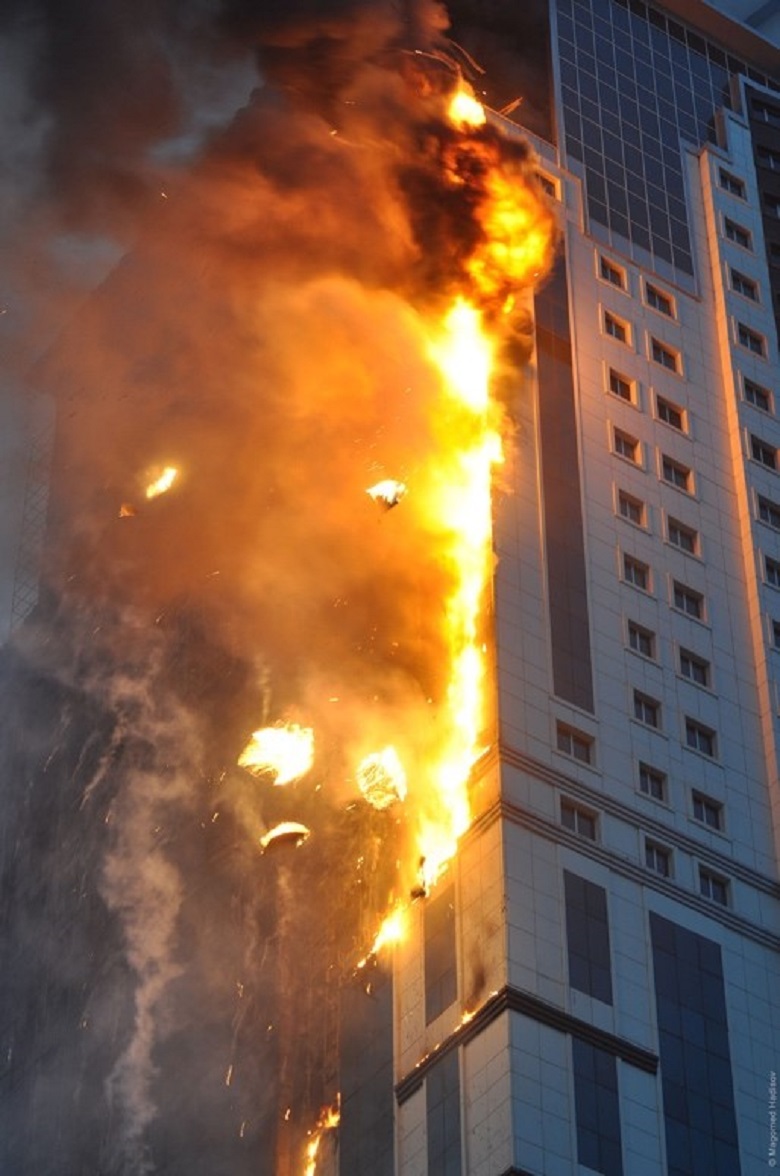

We confess that firefighters also came to our building site. Here is how it was.
CHRONICLE OF VIRTUAL FIRES
November 2016
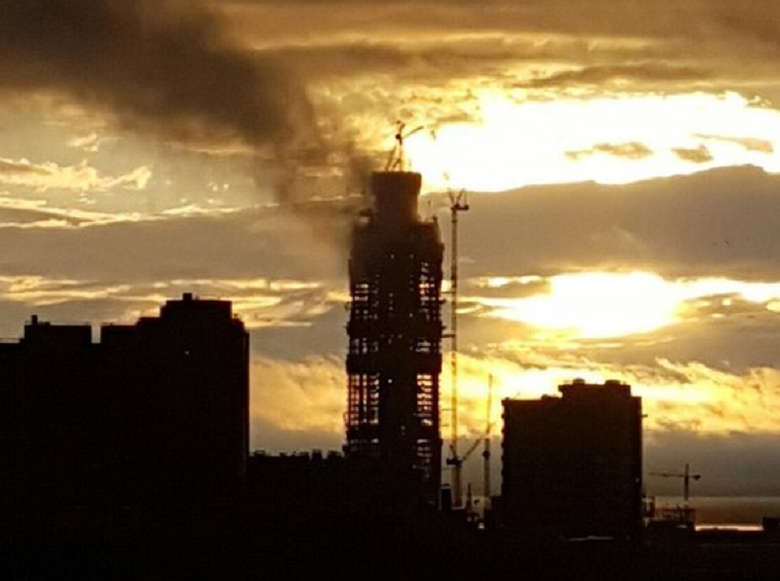
Users group “Lakhta online. Primorsky district "discuss:
- "It seems to have caught fire"
- “Yes, black smoke”
- “Vapers!”
- “Bob Marley's birthday is celebrated”
March 2017

“Nevskiye Novosti”: “Eyewitnesses stated that Lakhta Center is smoking ... The upper third of the tower is shrouded in something that looks a lot like smoke ... The circumstances of ignition are being clarified.”
November 2017
There are two “fires” at once - at the beginning and at the end of the month.
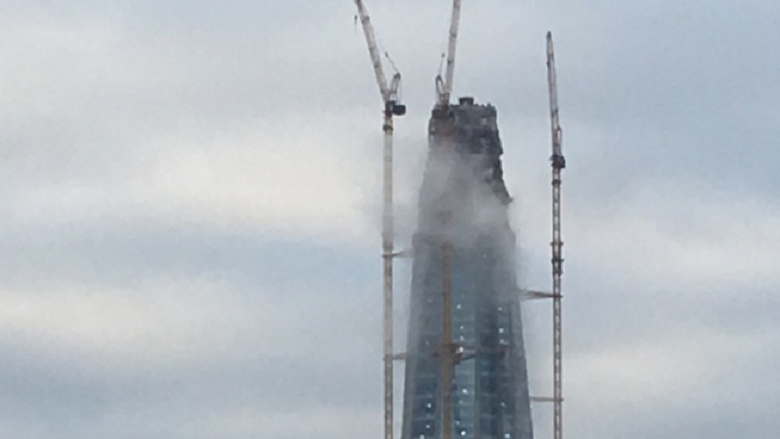
Social network:
- "You can see the smoke and its more and more, and the smell is slightly pungent at the height"
- “Our firefighters are not ready for such a height!”
- “Why aren't they ready?”
- “Do not smoke indoors!”
- “The eye of Sauron is beginning to flare up”
- "Instead of the Rostral columns lit"
- “Here you look in other countries on skyscrapers, so they have special equipment in case of fire, do we have ...?”
- “And the thrust is at the height of horoshoosha!) And fire safety to the devil”
- "White smoke. Strange "
- “White smoke because the Pope was chosen”
April 2018
Here, the "fire" was almost a week - from April 6 to 10, users of social networks again shared photos of the skyscraper, engulfed in flames.
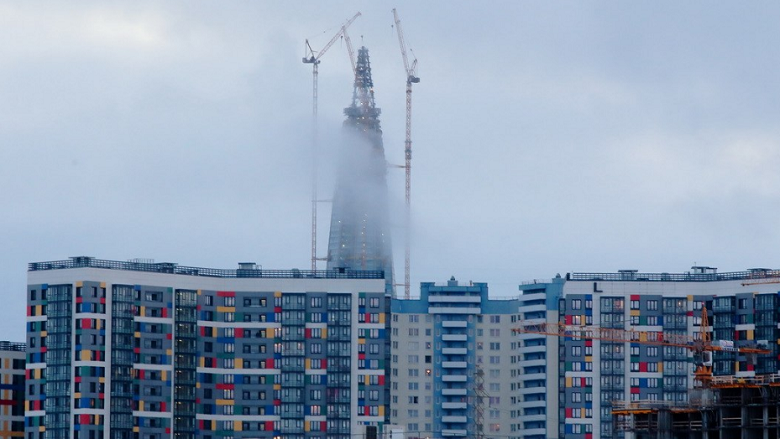
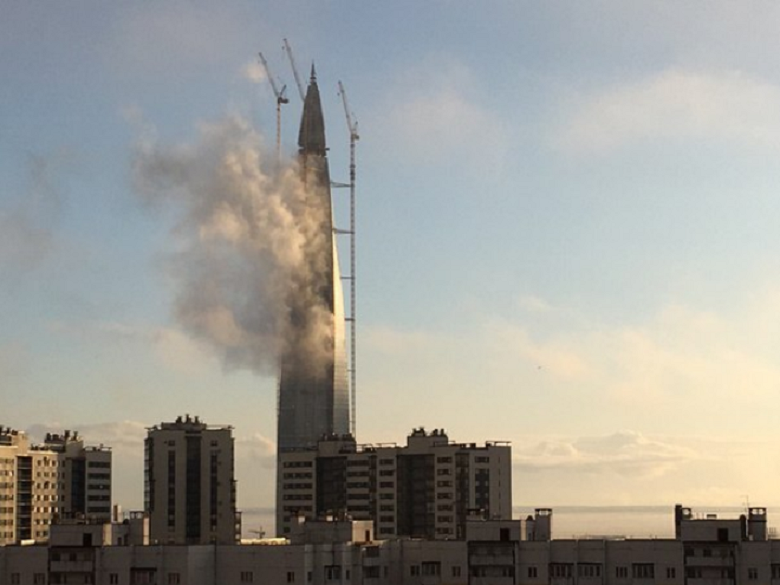
“Apocalypse in Petersburg!” - write some publications.
On the evening of April 6, Life opens up a live broadcast of the “fire”, but “... by 20:45, there is no trace of“ smoke ”left ...”, notes “Paper”.
The same photo, but in the author's treatment - artistic effects in the form of colored smoke act as pouring oil on the virtual fire:

September 2018
Well, the recent:
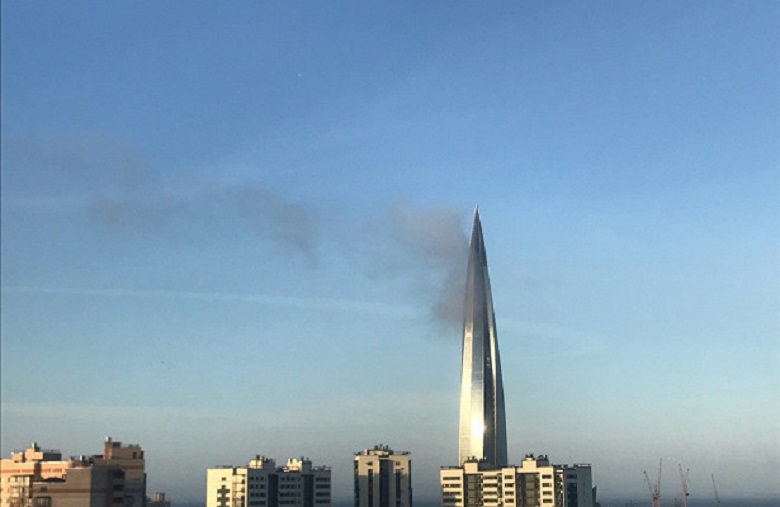
Photo 360 tv.ru
“Again it does not burn,” write the journalists. In social networks under posts with a “fire” instead of “First” in the comments: “Clouds!”
Someone always believes in a fire and calls the rescue service. Once, six fire brigades arrived at the construction site at once, then the Emergencies Ministry officially explained that no fire could be found. The September visit - by five crews, was short - from 7:30 to 7:55. Firefighters left again with nothing - to mutual joy.
The chronicle shows that “fires” usually occur in spring and autumn, when certain atmospheric conditions are formed - temperature changes, high humidity, low cloudiness. Sometimes low-flying broken clouds are to blame for the “sensation”, sometimes - increased evaporation from concrete works: as is well known, concrete gets very hot during pouring and hardening, while actively releasing moisture. There are still clouds of dust from construction work, blown out by a gust of good seaside wind and morning condensate from the metalwork of the spire.
Since all concrete work has been completed, and the building contour is closed, only cloudiness remains from the virtual fire triad. It is autumn now, just right to announce a competition for the best colored clouds in the region of the “upper third of the tower”.
As for the help of caring people who call the fire service - of course, we are grateful to them: the importance of calling emergency rescuers in case of emergency cannot be overestimated. But specifically the case of Lakhta Center - you can see the real situation through a live camera . And we have specialists who are responsible for the fire safety of the complex. These guys are not “The Rock” Johnson, they are cooler. Many in the past are fire brigade fighters, now they are doing everything intelligently and clearly to minimize the fire risks of a facility under construction.
I will tell you about the real fire just below.
HOW TO PROVIDE THE FIRE SAFETY OF THE LAKHTA CENTER CONSTRUCTION
Water line - high and marine
The height of the requirements for the fire safety system of skyscrapers is to match. The only problem is that during the construction phase these requirements and measures to ensure them do not work yet. Therefore, at the time of construction, temporary fire protection schemes are being developed. Part of the decision then goes to the permanent. According to Russian standards, the “outdoor fire-fighting water supply system for a building” is a water conduit, which is created even before construction begins.
Usually it connects to the city water supply network. For the Lakhta Center fire protection system, the municipal resource was supplemented with natural ones: the complex is located on the bank of a suitable fire reservoir in size.

A special fire pier was built on the shores of the Gulf of Finland, connected to the construction site with dry-tubes. The main source of water are hydrants, an additional one is water from the bay.
The temporary fire pipeline was growing throughout the construction period along with the building. Its buildup overtook the core: first of all, fire safety.

Main postulate of construction
Yes, and by the end of the construction we received another “most” - “the highest fire water conduit in Europe”. Thanks to him, there is always water in the tower. On each floor there are four fire hydrants, which are powered according to a rather complicated scheme.
A central pumping station is installed in the MFZ, which is able to pump water at the required pressure to the 17th floor of the skyscraper. There is an intermediate tank and another pump. There are five such intermediate stations in the skyscraper. They are located on technical floors dividing the tower into fire compartments.

Fireplug on the technical floor of the tower of Lakhta Center
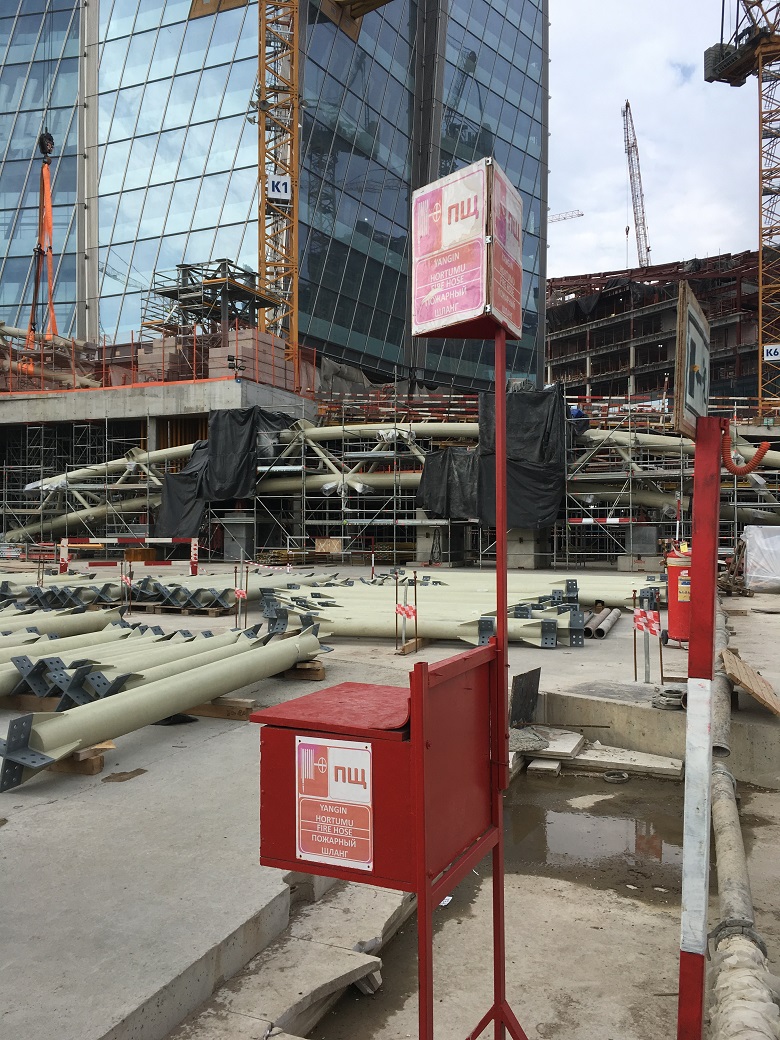
Fire hoses reserve
What to do with wooden structures?
Lakhta Center is a complex of steel, glass and concrete. From the point of view of firefighters - beautiful, non-combustible materials. Not that plastic or wood. Although, stop. Wooden structures at the construction site were used, and played a central role.
Let's return to the sources. On the zero cycle, while the foundation pit is being built and the piles are being driven in, there is nothing to fear - there is nothing to burn. Another thing is the pouring of concrete structures, which began at the stage of creating foundations, in the fall of 2014 for the Multifunctional building and in the winter-summer of 2015 for the Lakhta Center tower. Wooden formwork and all kinds of "greenhouses" are burning and how. For example, as on the 100-meter pylon of the WHSD cable-stayed bridge in 2016.

Therefore, the rules require high-rise builders to use non-combustible formwork and scaffolding. Which, alas, is too heavy. Because of this, the self-elevating four-level formwork used in the construction of the foundations and the core of Lakhta Center was still wooden, but its application was enclosed in real armor from the conditions and rules.



Self-moving formwork on the core of the tower Lakhta Center. Consists of steel bolts and wooden elements, including flooring and thick laminated plywood - potential sources of trouble
For the use of "combustible" devices have been developed STU, which approved the regulatory advice of the General Directorate of Emergencies in St. Petersburg. The document prescribed the organization on the formwork of deluge fire extinguishing systems, fire alarm systems, emergency warning systems. All formwork structures were covered with flame retardants.
Fire and metal
Alexander Smirnov, Fire Safety Engineer, Labor and Safety Department, Lakhta Center:
- For the period of construction, three STUs (special technical conditions) for our facility were issued concerning fire safety, which prescribed additional fire safety measures for the facility, as well as “burdening” the current RF standards. This was done due to the absence or incompleteness of regulatory documents on fire safety in the Russian Federation for buildings of such a height.
Total STU covered 20 points, not regulated by regulations. Due to the inconsistency or lack of some regulations regarding unique buildings, a single, but loud, “fire” dispute arose around the construction site. He dealt with the timing of processing metal structures with flame retardants. “Immediately after installation of the structures,” the inspectors insisted during one of the trips. In response, an order was issued from Rostechnadzor to take into account in its work the standards of the industry SRO NOSTRO. And there - in black and white: after installation of engineering systems with elements of their fastening and reinforcement, completion of all welding works, cleaning and priming of weld seams with anticorrosive primer and further on items 5.2.1, 5.4.1, 5.4.3 and up to 5.4 .16, as well as - p. 375 RFID of the RF. The question faded away without flaming.
Of course, nobody tried to “save” on flame retardant coatings for metal, as some observers suggested. The question is exclusively about the regulations and conditions for the application of fire protection - the air temperature is not below steady plus 3 and not in the open air. The importance of fire protection itself is beyond doubt.
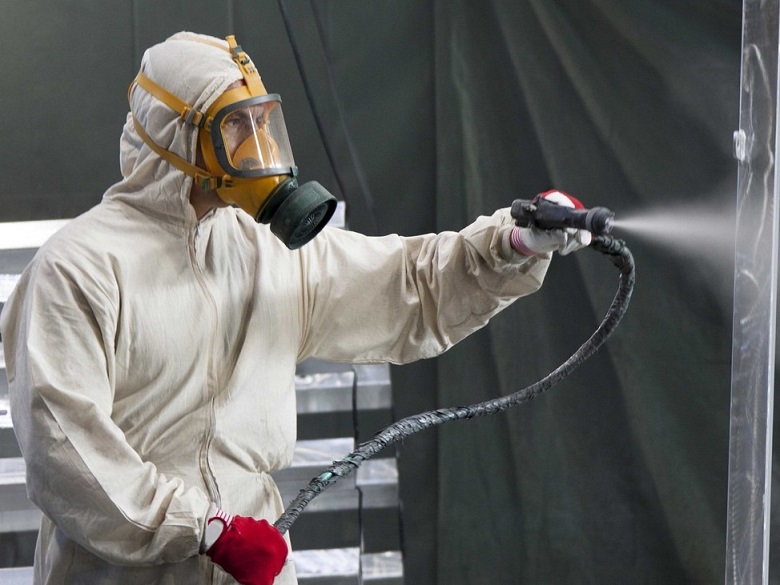
In case of fire, the bearing properties of metal beams that are not covered with flame retardants, retain their characteristics for about 15 minutes, then deformation begins. After treatment with flame retardant compounds, the time increases - up to several hours. In the case of emergency even extra minutes can be saved lives. But the clock is a valuable time to evacuate and fight fire. There has already been repeatedly discussed the case of the collapsing collapse of New York "twins", according to the findings of the investigation caused by the fire and the rapid deformation of steel columns. No one wants to even remotely repeat this experience, so everything is used - both flame retardants, and outrigger belts and safety zones in a reinforced concrete core that can withstand fire for 4 hours.
Bearing beams of interfloor ceilings in the tower and MFZ are treated with constructive fire protection. Externally, it is a kind of non-combustible fluffy plaster with extremely low thermal conductivity.
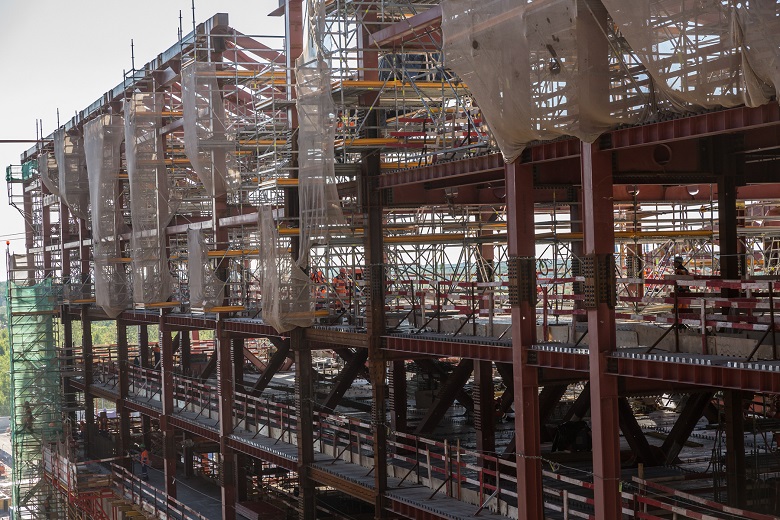
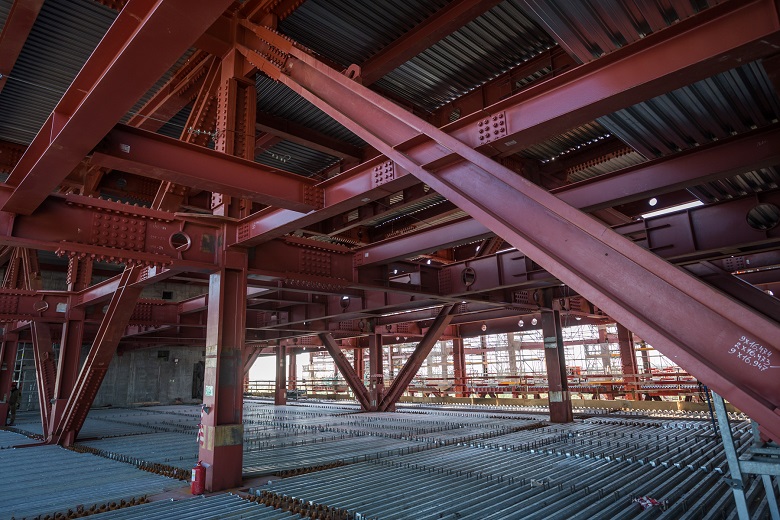
Interfloor beams of a multifunctional building before flame retardant treatment
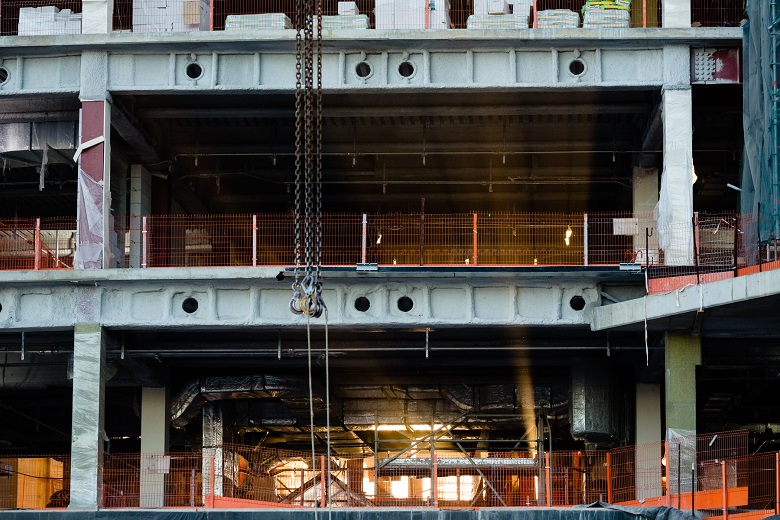
The beginning of processing - there will be several covering layers, after which the beams take on a frosty look.
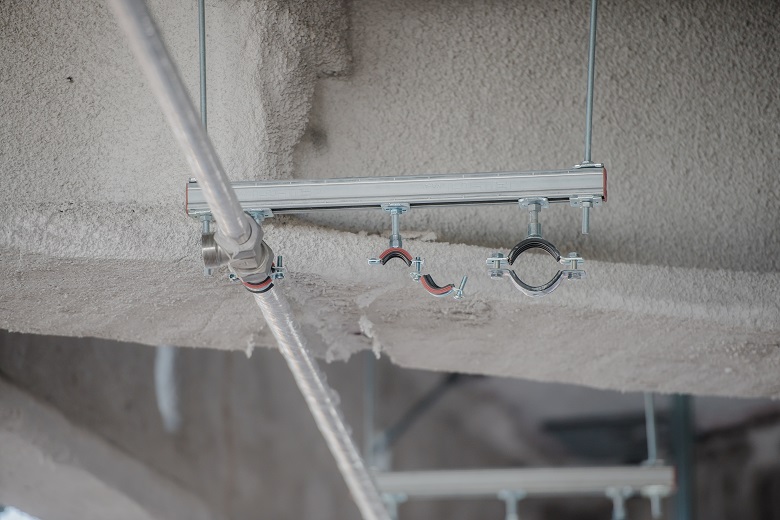
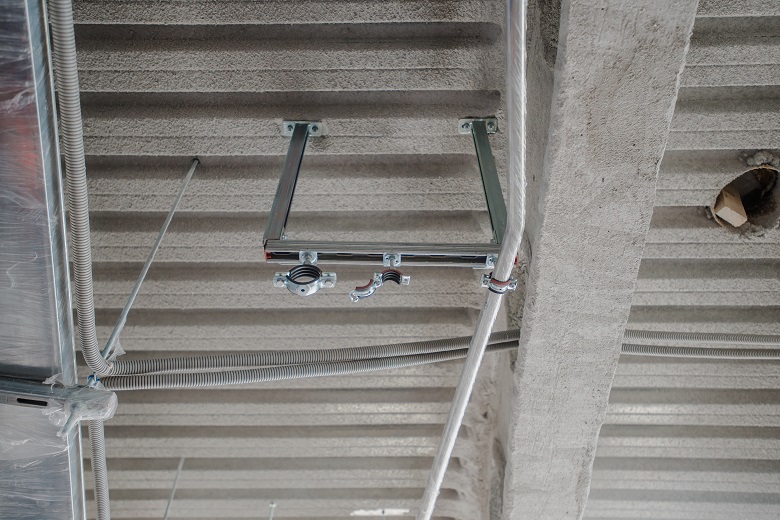
Treated interfloor tower floors, view of the composition near
Several layers of such “plaster” provide the limit of fire resistance of floors two times higher than the standard - at the level of R 240 - 4 hours of fire without changing the properties of the metal and the geometry of the structures.
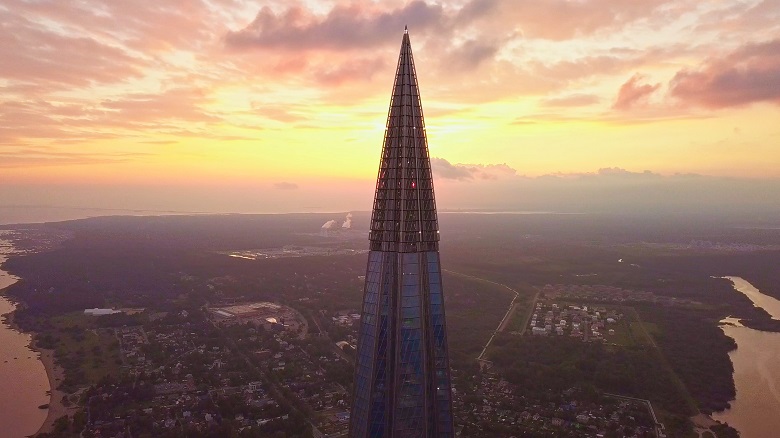
The metal structures of the spire are treated with thin-layer structural fire protection, which is more suitable for outdoor conditions.
Fire Prevention Team
The fire station is located nearby - Morskaya Street, Building 3.
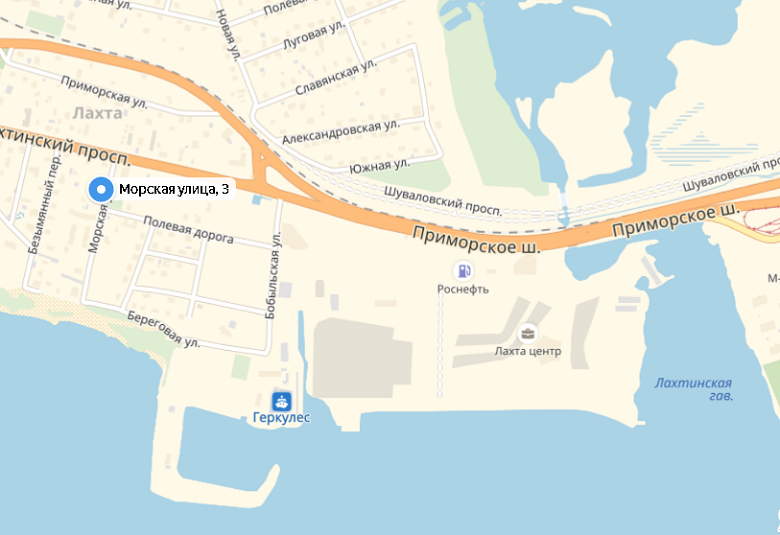
To arrive at the construction site, firefighters need only 4 minutes. How to make sure that they do not come at all? Or - if an emergency has happened, how to use these 4 minutes with maximum benefit?
The answer is the presence of its own fire-fighting group, whose employees are on duty around the clock on the construction site. Their task is to ensure that every builder complies with all fire safety rules. Trite? Yes. But you really need an unfortunate confluence of circumstances or a unique force majeure to make a fire happen when all the rules are met. The main cause of accidents is a violation of what everyone knows. Yes, the type does not carry out hot work next to combustible materials. Not to mention the classics - not extinguished cigarette butts thrown into the construction debris.
Alexander Gladilin, Lead Engineer for Fire Systems Lakhta Center:
- The fire prevention service was created at the facility by the contractor - Renaissance Construction, since its arrival at the facility and since then has been working 24/7.
This is a separate subdivision, whose duties include finding and stopping violations, calling the fire brigade in case of emergency, and until regular units arrive, the primary extinguishing of a fire, organizing an evacuation, upon the arrival of the fire brigade - meeting and escorting firefighters to the site , which reduces the search time of the fire.
The group of quick fire response includes more than 50 people, taking into account day and night shifts. Employees of the service can be distinguished in a standard way for builders - by helmets: they have light green color.
Every day, these people are looking for weak spots - they are present where welding and fire work is going on, checking for the presence and functioning of “primary extinguishing agents”, alarm systems and voice alerts — fire extinguishers, water mains, information signs.
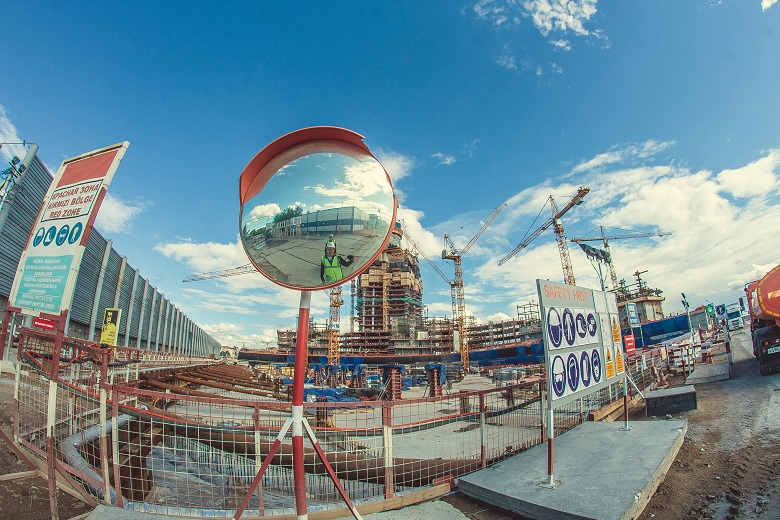
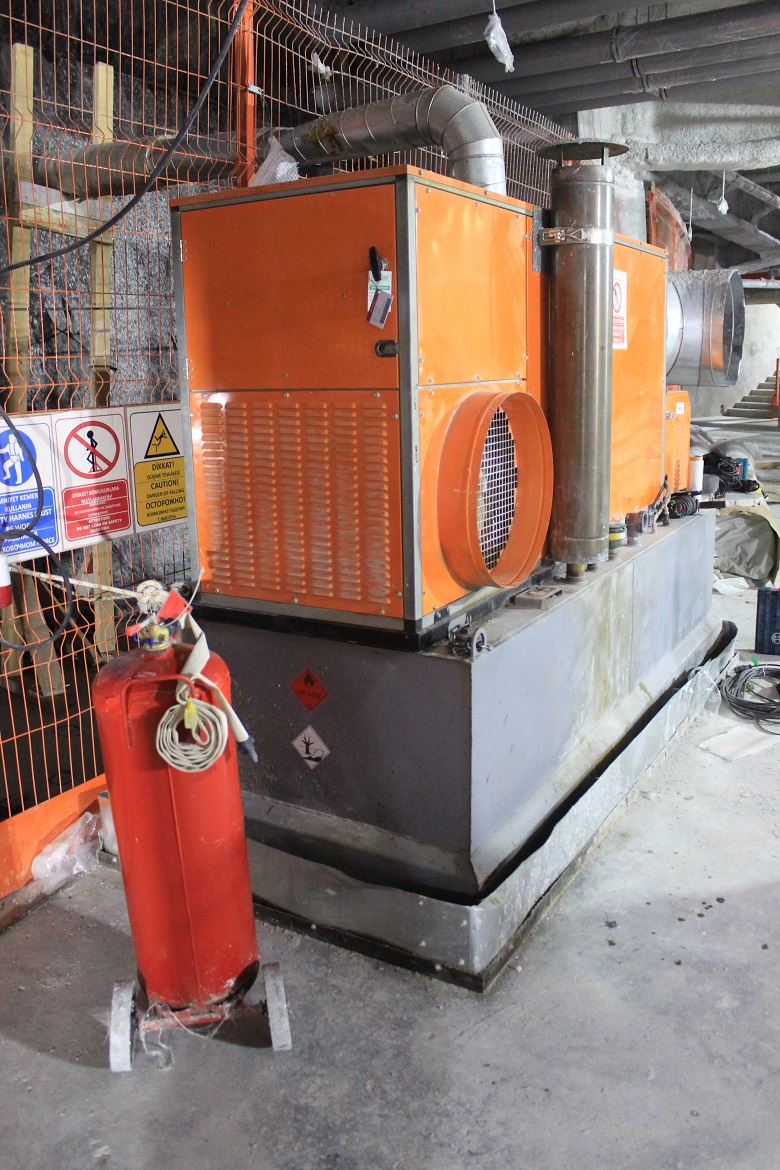

Primary extinguishing agents and information signs at a construction site are everywhere. Standing at one - see the next
Shovels and sandboxes, fire extinguishers and instructions for their use at a construction site can be found everywhere, even in the most unexpected places. For example - here is a fire extinguisher at the Lakhta Center layout site.

It would seem, what is there to burn? But the power of the rules - in their strict execution. Put - means nothing to talk about.
Does not burn where it is clean
At the construction site of Lakhta Center it was always neat - as much as possible in the conditions of construction.
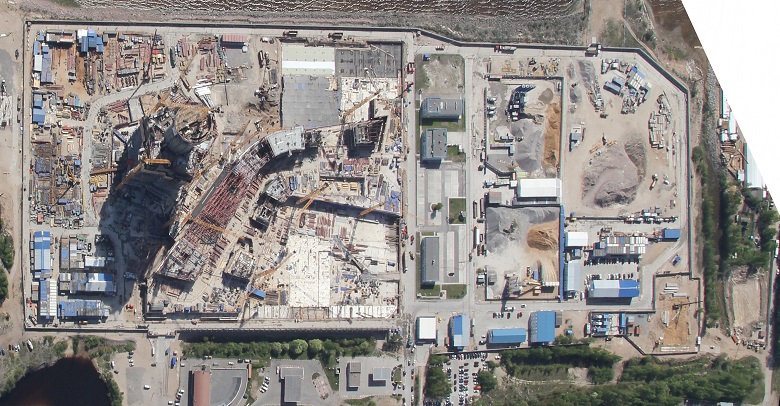
In 2013, "The best construction site and household town" was awarded in the professional contest "Stroymaster". Interestingly, such accuracy - the characteristic and fire safety. Construction debris - a nice kindling. Therefore, each work shift at a construction site ends the same way - the export of industrial waste. This is a constant constant in a rapidly changing construction process.
Stroygorodok - the area of life. And here - it is especially important not to relax. For example, there are special rooms equipped for drying shoes and clothes - otherwise people would have to do this on heating appliances. Made places for smoking. No, there are no sites for kebabs - this is only outside the construction site.
Temporary office buildings and construction sites are protected by an automatic fire alarm and modular powder fire extinguishing systems. Due to space saving, the objects are close enough to each other, so in case of emergency, water curtains will work between buildings.
People
Have you noticed that the human factor is the main driving force of emergency situations and catastrophes? Events overlap one another, but in 9 out of 10 cases, investigators say something like: "If this Skettino followed the course ...". Yes, in our century of the fourth technological revolution, people are still the main force majeure and the main character.
Alexander Smirnov, fire safety engineer at Lakhta Center:
- All these numerous and rather complex technical systems protect the construction site from fire, probably, by 10%. The remaining 90% are dragged by people who are engaged in fire prevention. After all, almost always the cause of the fire is the human factor. This is an everyday routine work that nobody seems to see, but believe me, there is a lot of it.
With the "human factor" struggling punishment and enlightenment. The punishment for violators of fire safety regulations at the Lakhta Center construction site is dismissal.
As for enlightenment, it is set on wide rails. Instructions on safety regulations are all, and once a month the builders - fire drills.
Trained to evacuate. To the request to tell about the teachings, our firemen wave them off - they say, this is standard work.
Lead Engineer for Fire Systems Lakhta Center Alexander Gladilin:
“Everything is as always and everywhere: an alarm sounds, people stop working, go out, gather in specially designated areas, responsible persons check the availability of personnel. This is a routine, but a routine is very important. And I can say with satisfaction that there was not a single case when someone did not have time to leave the danger zone until the moment when, according to one or another scenario, the main escape routes were blocked by dangerous fire factors. ”
Or here:
Alexander Smirnov, Fire Safety Engineer, Labor and Safety Department, Lakhta Center:
“Exercise scenarios? In the script there is nothing interesting for the article, these are not those beautiful teachings that are shown on TV, we do not heroically save anyone! In our exercises, workers are evacuated from the building and the interaction of the facility’s services, electricians, employees of the BCP, lifters, construction site managers, crane operators, people in charge should all know their tasks when they receive a fire alarm — who should call, turn off, where to evacuate report on the number of people evacuated, how to meet the arriving fire engines, etc. etc"
Well, no, about the heroic salvation, we have already seen - in the previous post . Properly organized routine is what really matters. Here are some photos from the March 2016 exercises. Then, according to the scenario, the formwork “burned” on the 17th floor of the tower, the situation was complicated by the presence of the “wounded”.
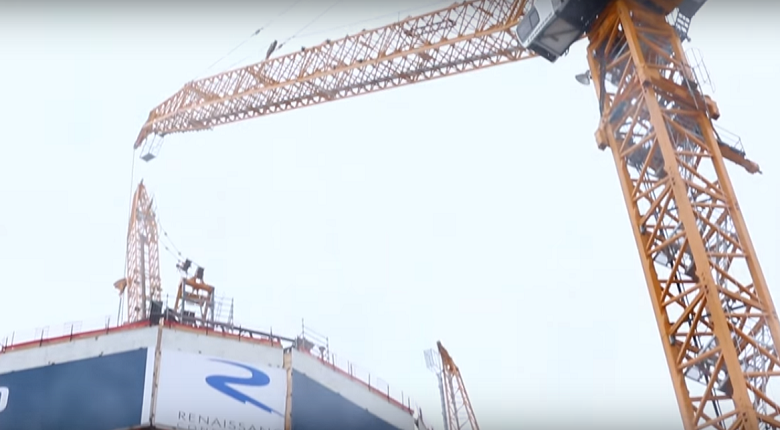
The tower crane is one of the “big ka”, takes a cradle with a “victim”.
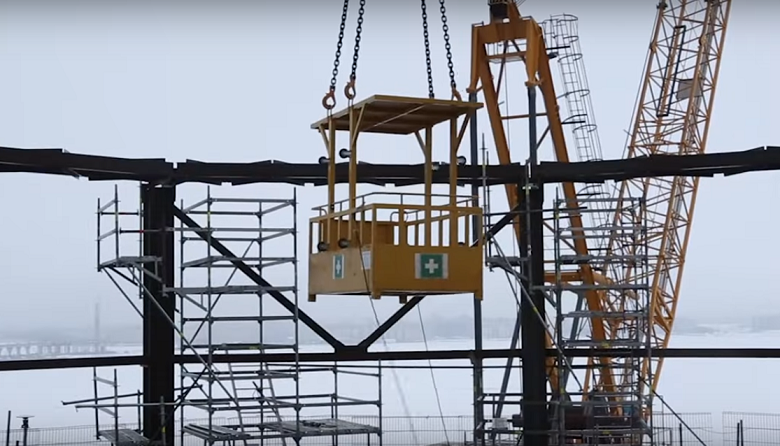
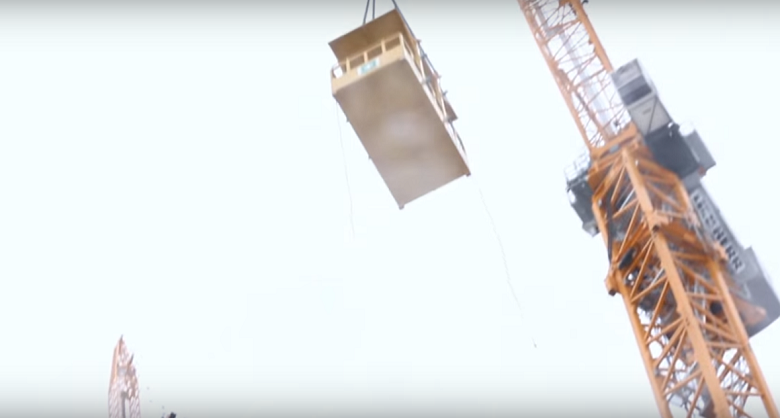
And carefully evacuates it from the floor to the ground.

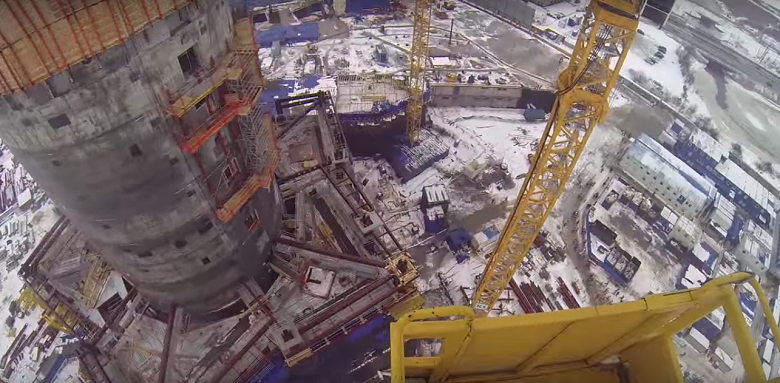
A good overview opens from the cradle - but the “victim” does not have the opportunity to evaluate it: it’s just a dummy.
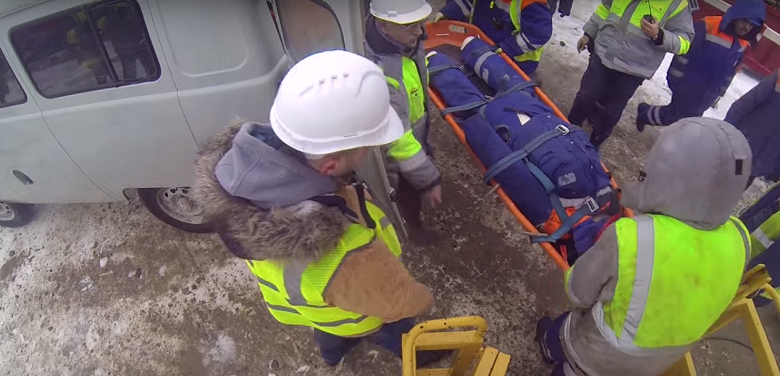
The "victim" is sent on a stretcher to the "ambulance." And this is the evacuation from the “dangerous” and the highest floor - at the time of shooting in 2016, it seemed then that the 17th was very high. Here, according to the teachings legend, the formwork “burns”.
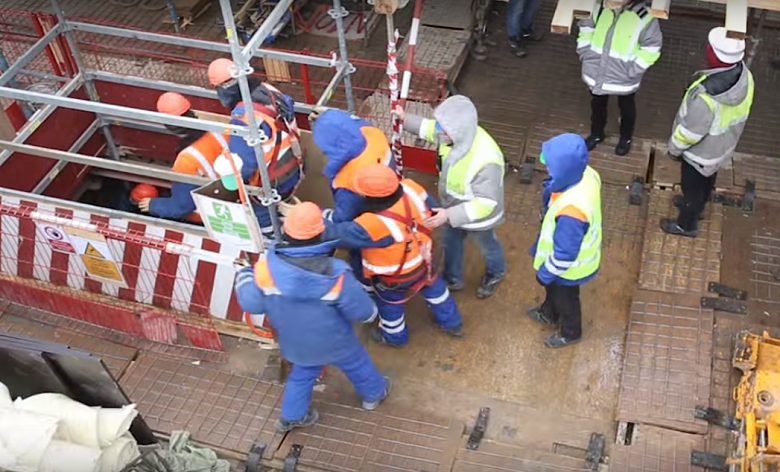
The captains, that is, the engineers and technicians, are the last to leave the floor after the ordinary workers and brigade leaders have left.
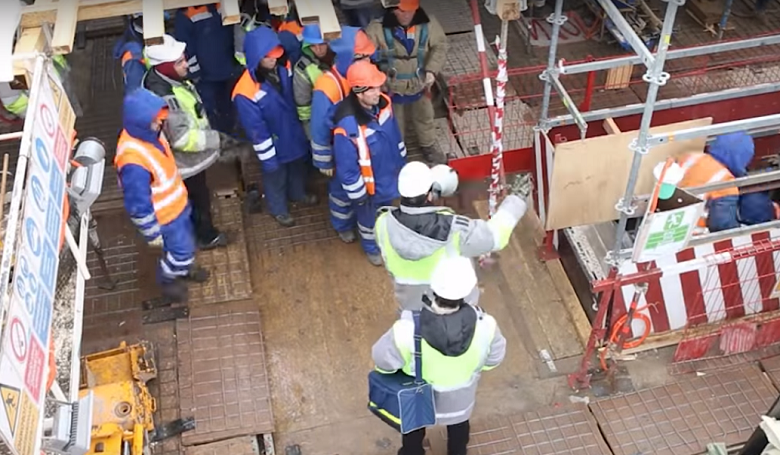
The estimated time to reach the escape ladder is 45 seconds, leaving the floor within 2 minutes. The engineer, who is responsible for evacuation, regulates the process with the help of commands sent through the loudspeaker. After evacuation - debriefing.
Such exercises were conducted both in the daytime and in the dark. The need for quite frequent trainings is connected with the fact that the tower was constantly growing, the evacuation paths were changing and people had to learn a new road with their feet.
It was with the teachings, and not with the clouds, that the first incidents of observers were worried about a fire at a construction site. For the first time, the sound of a training fire siren carried around the neighborhood scared the locals out of joke - they called the construction site to make sure everything was in order.
And if it lights up?
Then - everything was worked out. People will go to the escape stairs and leave the building.

One of two escape stairs in the core of the tower.
To evacuate builders, all exits to the stairwells are equipped with fire resistant doors.
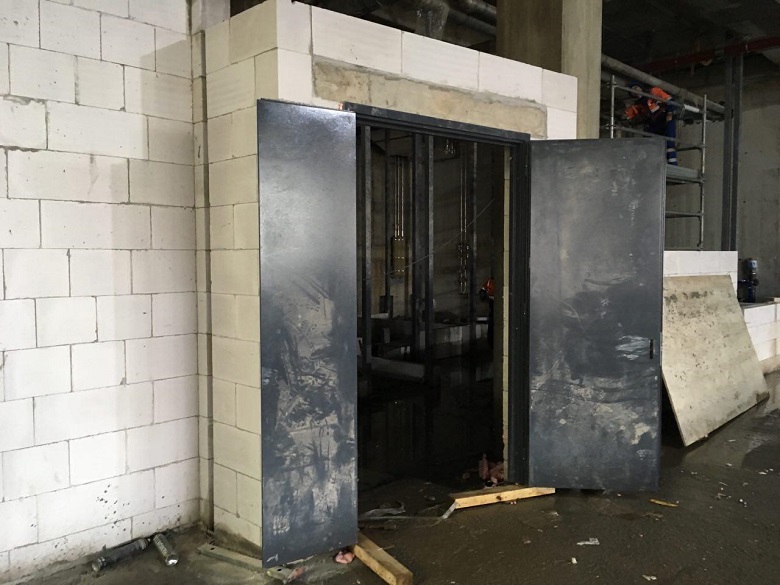
The doors are temporary, and such luxury can hardly be found at any other construction site is quite expensive. But in the unfinished, with this glazed building smoke to go except for the stairs there is no place, and the air backwater evacuation routes are not included. It means that a reliable barrier must be created between the people who are fleeing and the fire. Temporary fire doors installed for the safety of builders can hold back the spread of fire and smoke for about 30 minutes - enough to leave the fire compartment.
What is special about the fire protection of the Lakhta Center construction site?
Probably nothing. Except that here everything is according to the rules that are being enforced. Already almost a unique situation.
Alexander Smirnov, Fire Safety Engineer of the Labor and Safety Department of the Lakhta Center:
- I would say that everything at the facility was done in terms of fire safety as it should be! It’s just that not at all construction sites this is done in full ... For example, often at a construction site you may encounter a temporary fire alarm, a temporary fire warning system, a temporary full fire-prevention water supply system on all floors of the building, including the freshly flooded ceiling, there are even in certain places temporary modular powder fire extinguishing? It seems to me that no! And we have)
***
Firefighters are probably a little superstitious. They will not be praised by the fact that for the entire past period there have been no fires so far. But he was not there. And this is an achievement - not noticeable to outsiders, but so important. Superhero.
I promised to tell you about the real fire?
Here it is - such crimson, burning sunsets were over the construction site of Lakhta Center in July of this year. Just fire!
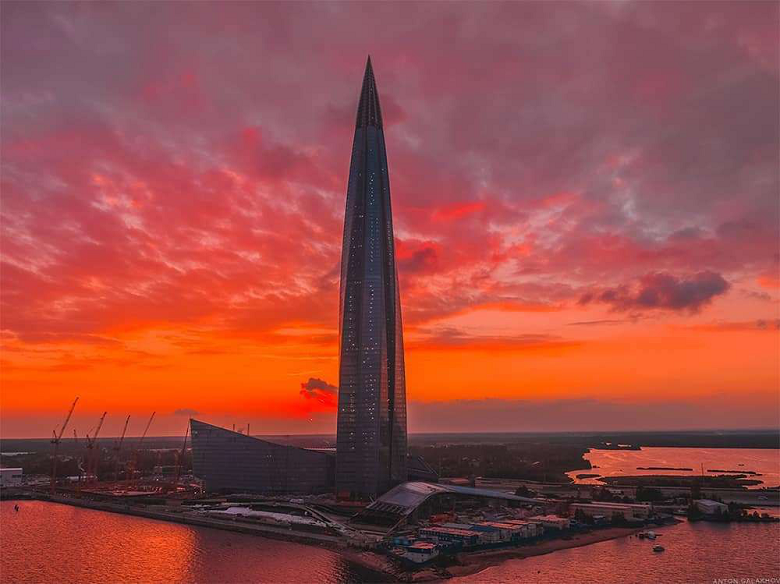
Photo - Anton Galakhov
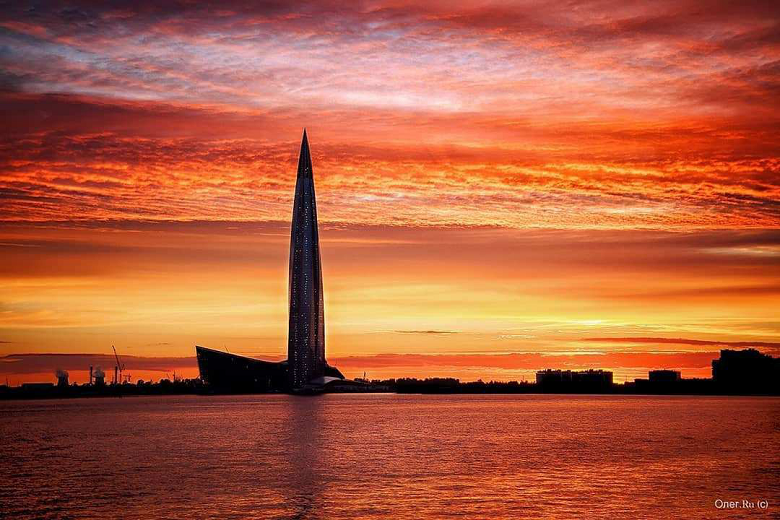
Photo by Oleg Rudin
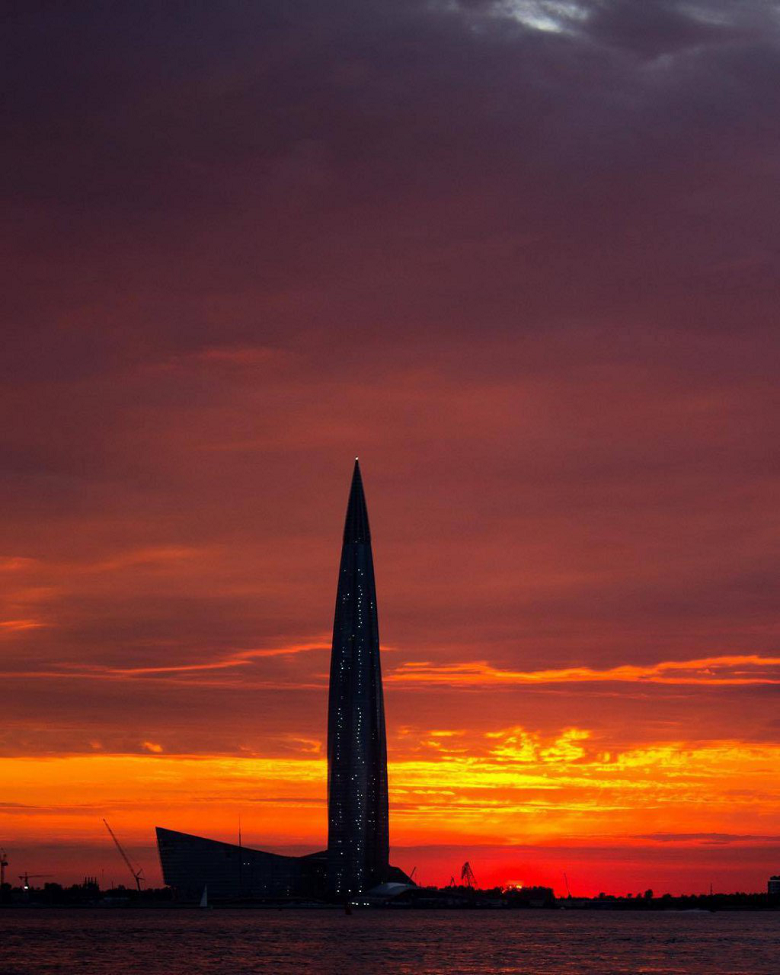
Photo - Mikhail
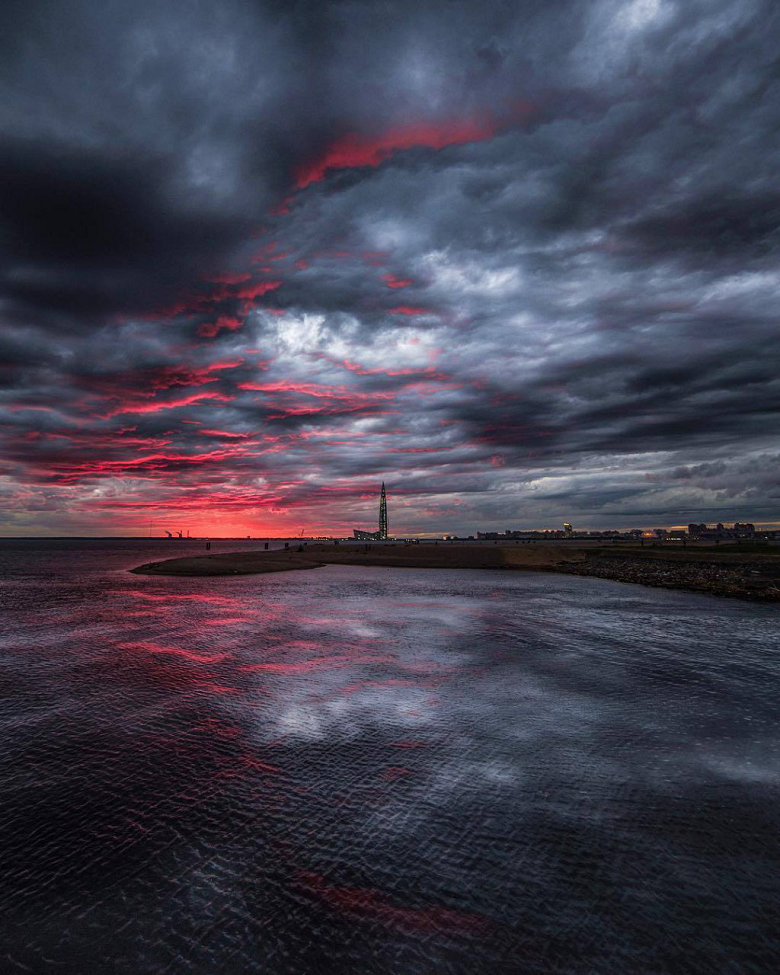
Photo - angelshula
A well-known sports commentator Tankredi Palmeri signed his photos “St.Petersburg is on fire”, “... burning sky where the

fires are the only correct ones. I wish everyone to face only such.
***
How Lakhta Center will be protected from fire during operation, read in the second part of the review. We will talk about how to evacuate 8 thousand people from a skyscraper, to which temperature during a fire can heat the glass of the facade, which is common between a tall building and an oil tanker. There are also answers to readers' questions: how to evacuate if a fire occurs on the first floor and about the ethics of leaving the building during a fire - a commentary on the passage from the book “Crises and Catastrophes. Who survives and why. ”
***
For assistance in preparing the material, thanks to Alexander Gladilin - Lead Engineer for Fire Prevention Systems, Alexander Smirnov - Fire Protection Engineer of the Labor and Safety Department, Pavel Vinokurov - Head of the Construction Control Department, Alexei Sivokho and Igor Romanenko - Construction Control Engineers of Lakhta Center
Source: https://habr.com/ru/post/424621/
All Articles